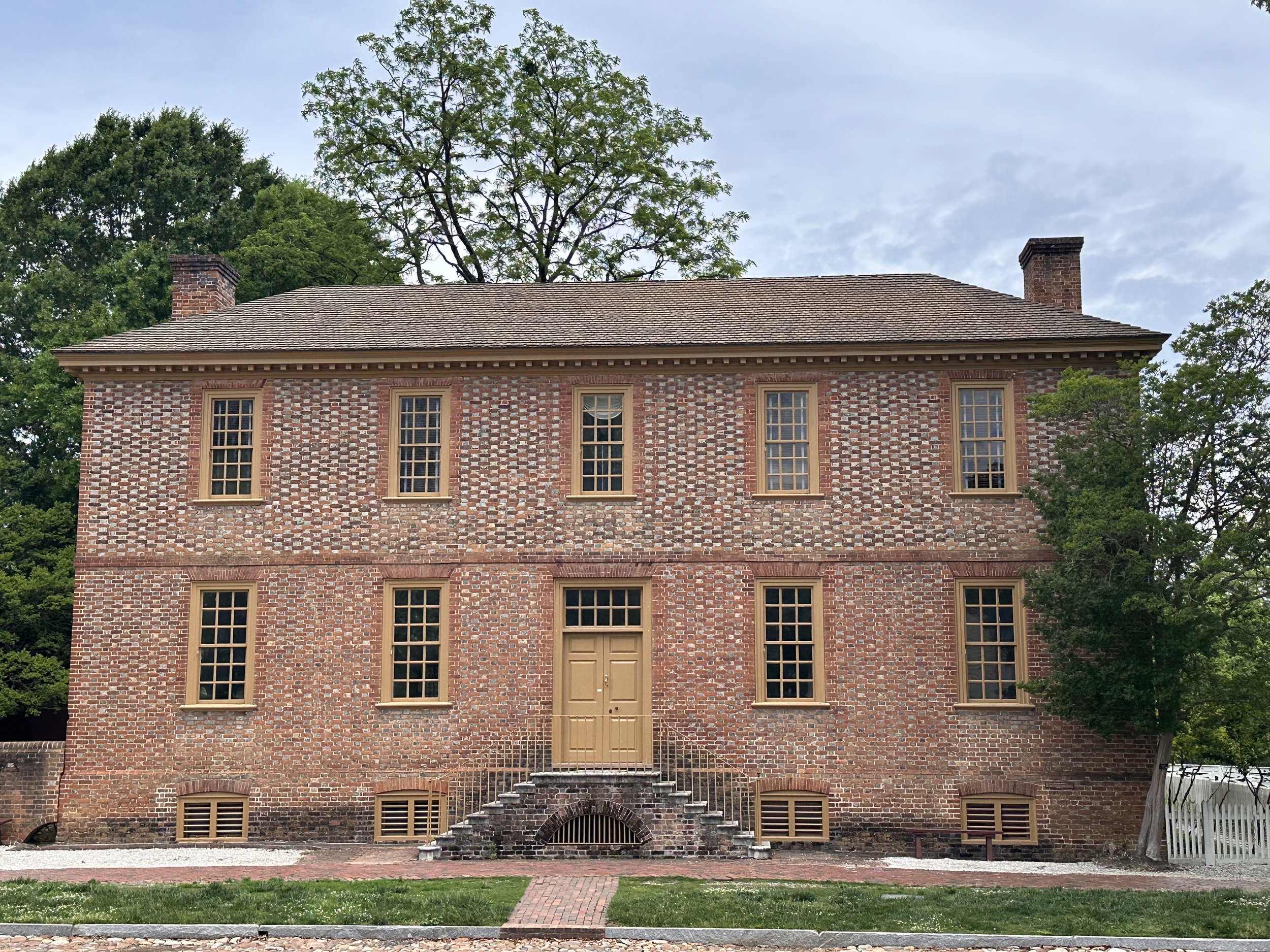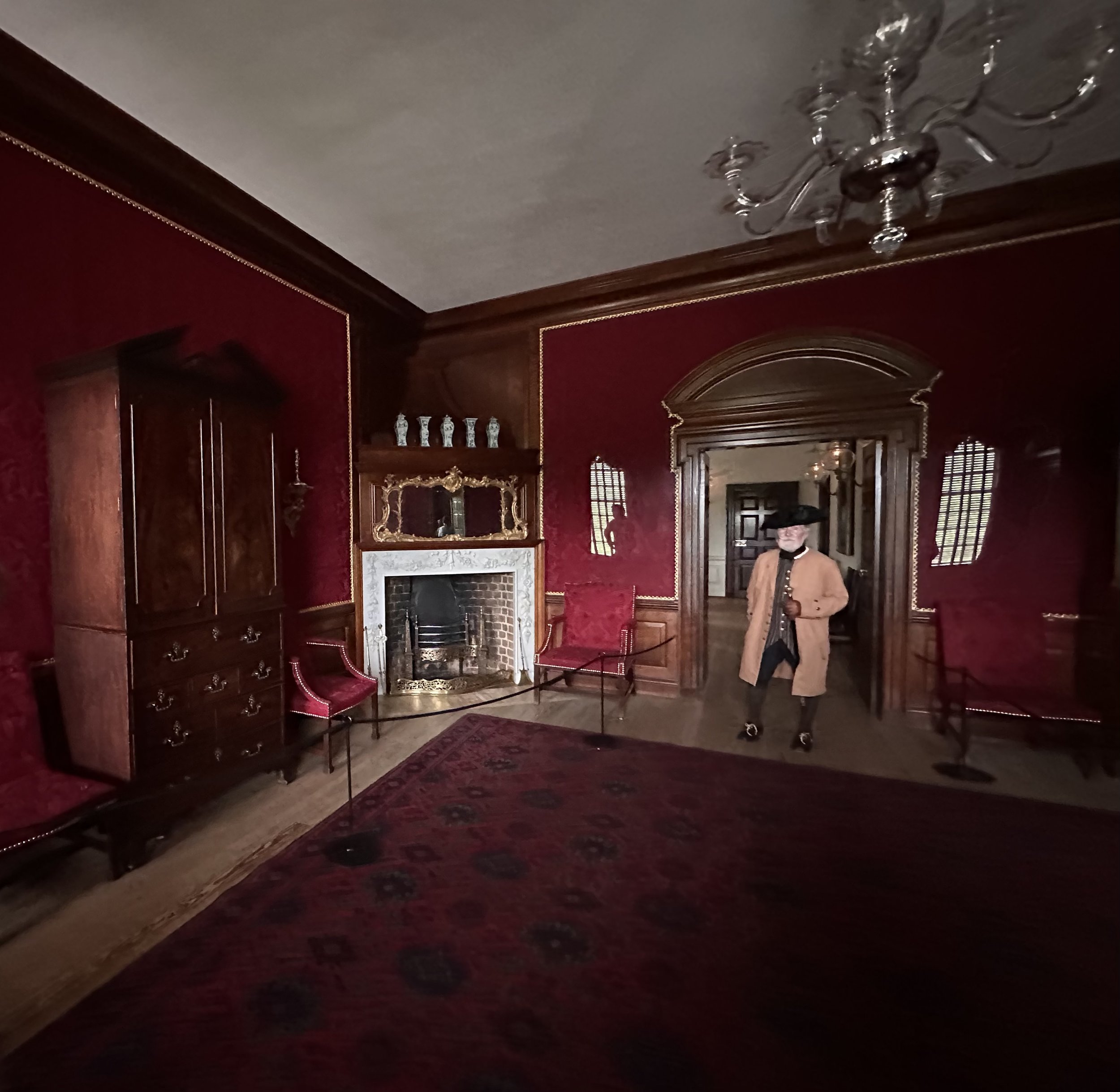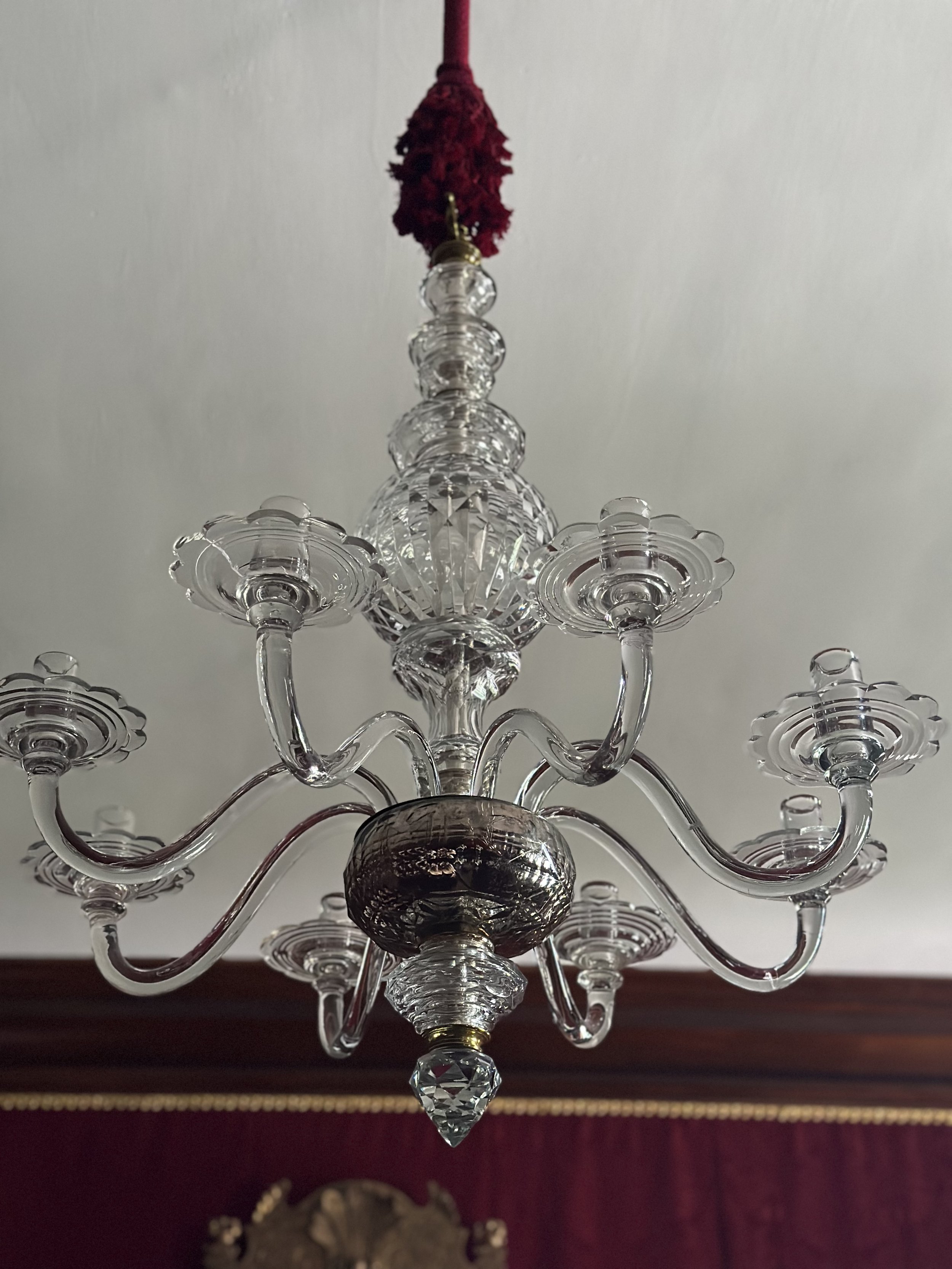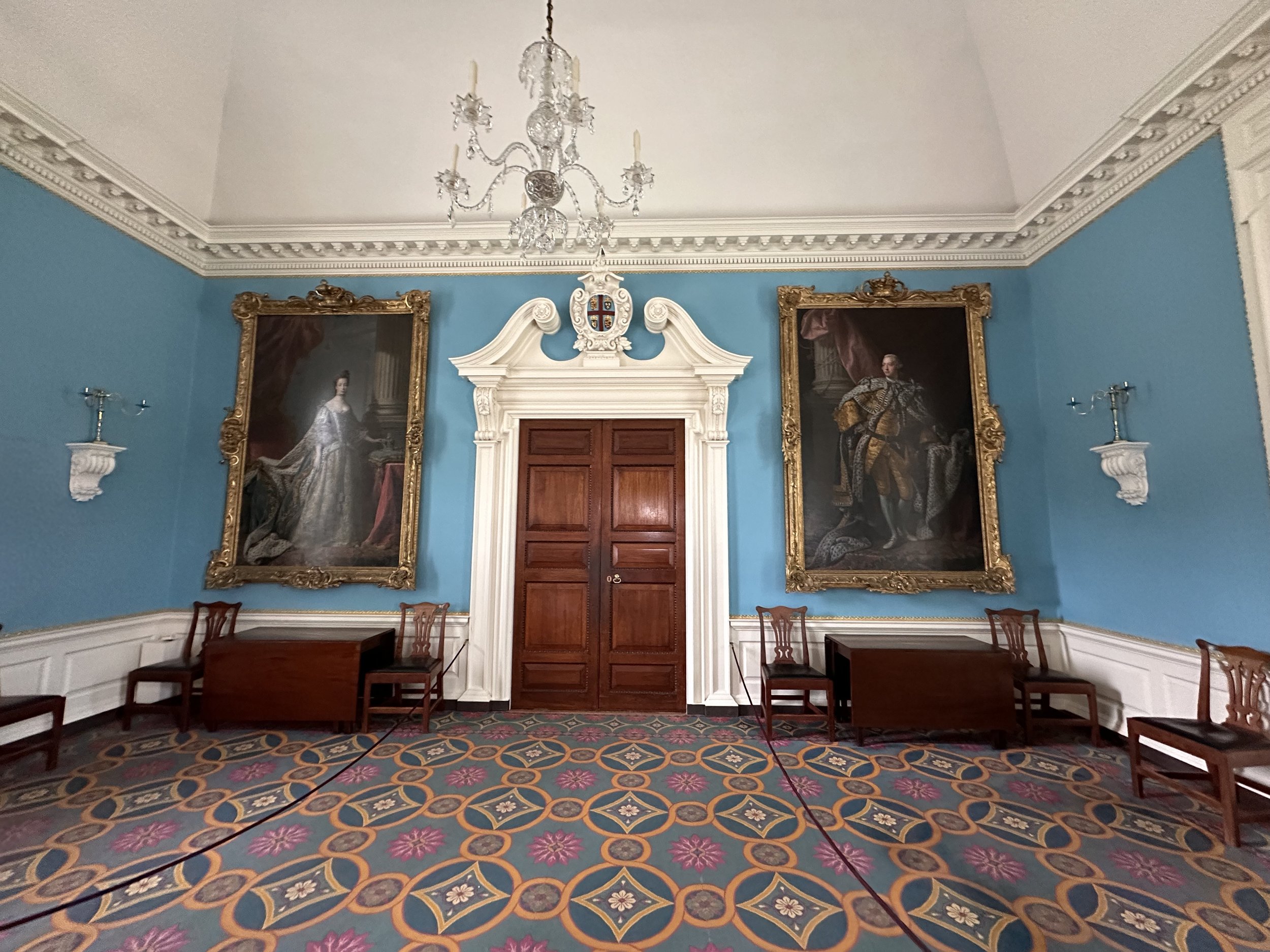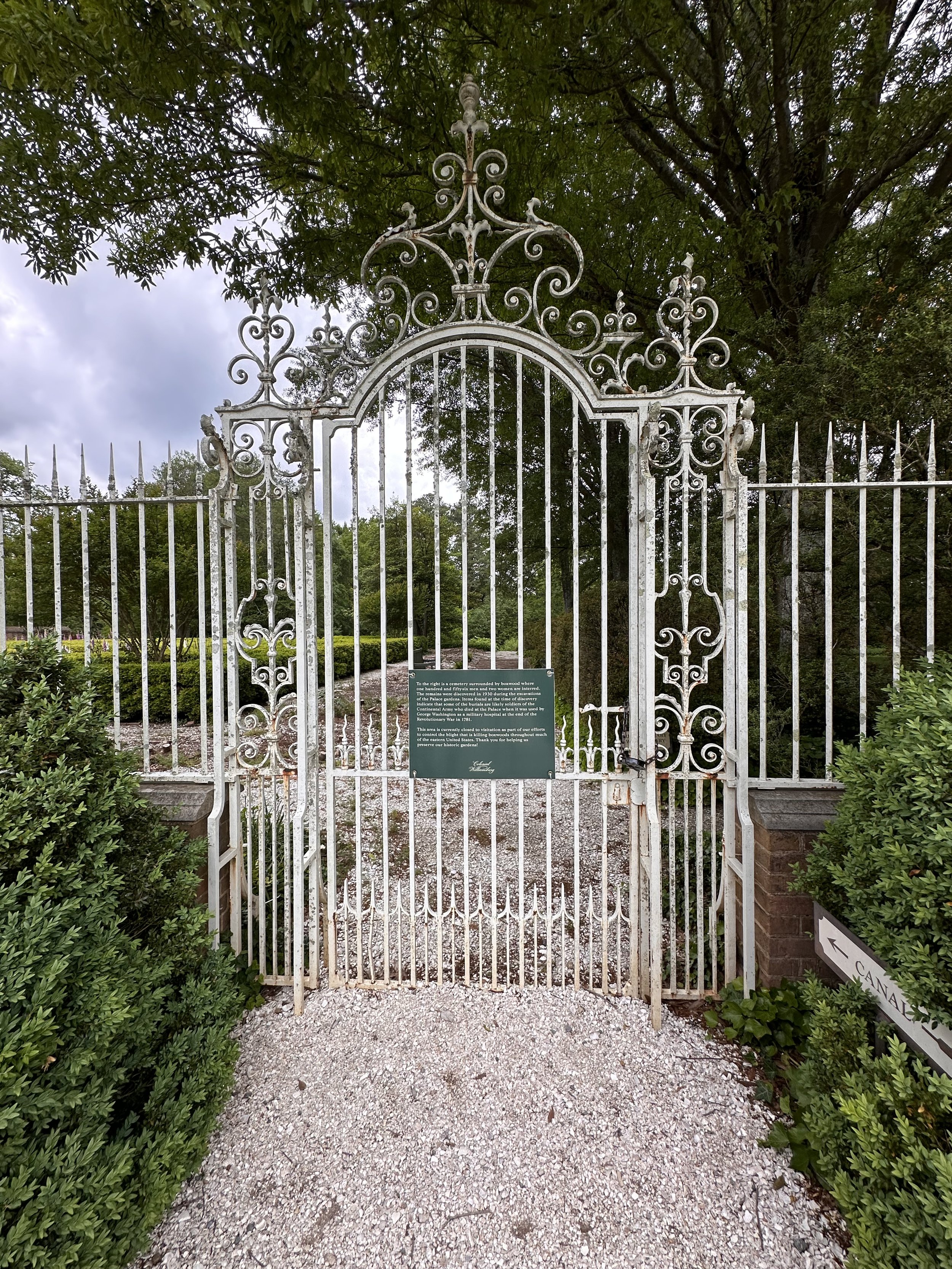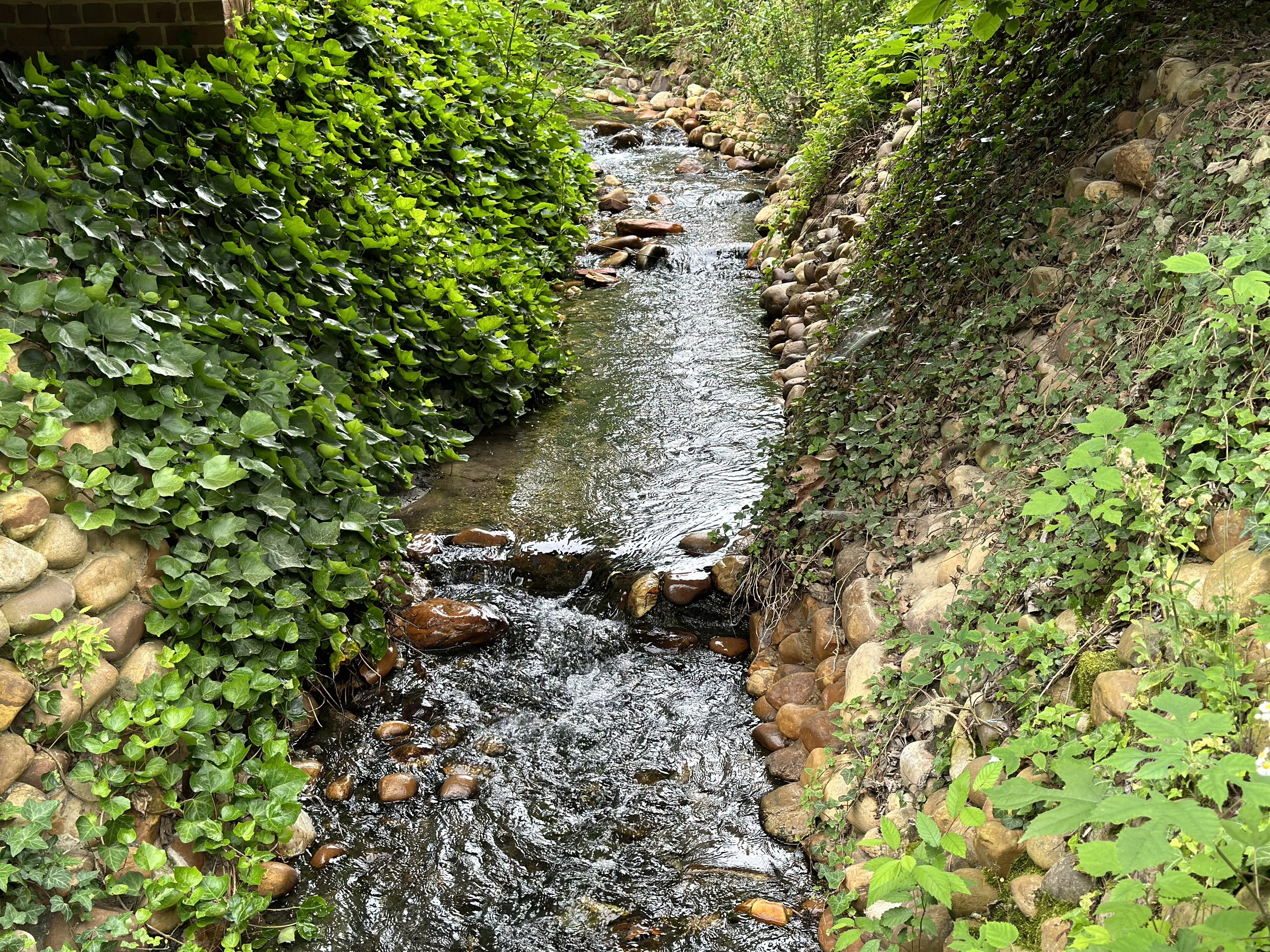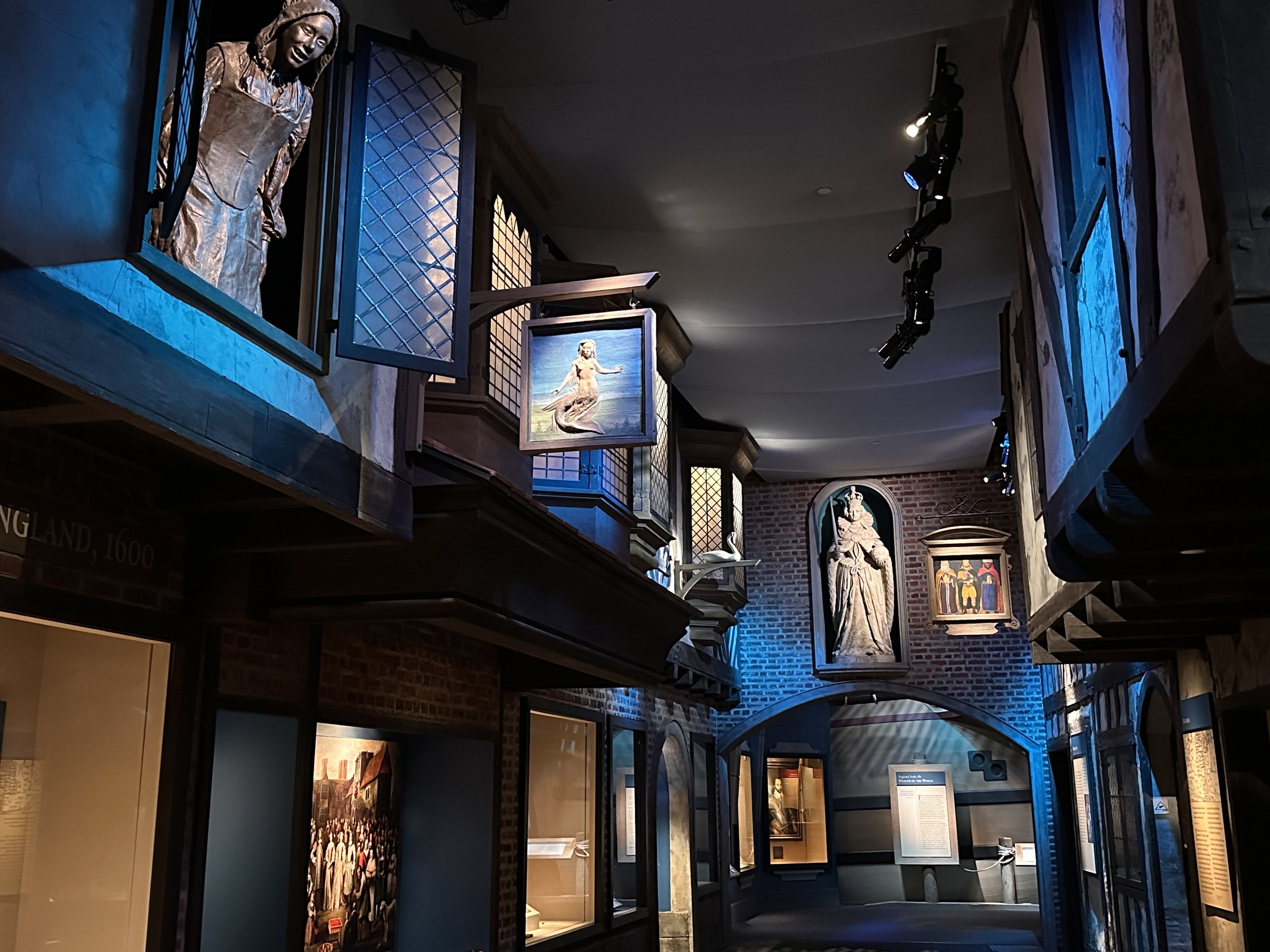Exploring Colonial Williamsburg, Va
Time needed in this town: 3-4 nights
Colonial Williamsburg was one of the single most expensive (and extensive) restoration projects in the country. Had it not been for Reverend Dr. Goodwin and the Rockefellers, we would not be able to immerse ourselves in the history that shaped and started this country. You can get lost in the streets of old colonial homes that are private residences, wander the grounds of William & Mary, and interact with colonial guides who teach you more about some of the most important buildings in the town. If you haven’t put it on your list to explore in Virginia, you must.
The below information is a complete guide of the best places to stay, the top rated places to dine and drink, and all there is to see and do. We’ve also included a summary of the history of this super historic town!
Jump To:
Where to Stay
Williamsburg Lodge is mere steps from Colonial Williamsburg and is one of the official hotels of the town. I realize the hotel room doesn’t look like much, but it is clean, comfortable, and well-priced!
Other recommendations
Williamsburg Inn - The late Queen Elizabeth, as well as other members of the royal family, have visited here on a few occasions! It’s also said to be incredibly haunted.
Where to Dine & Drink
Fine French brasserie fare with some American leanings in a sunny, teal-&-tangerine space.
Christiana Campbell's Tavern
Per their website, “George Washington frequented Christiana Campbell’s Tavern for its delicious seafood in the 18th century. Lively conversation and learned discussion have returned to Campbell’s Tavern. We are looking forward to welcoming back guests this spring to enjoy our historically inspired, locally acquired menu of shrimp, scallops, and fish, and of course our world-renowned crab cakes and spoon bread.” There’s also a wine cellar available.
Fat Canary
Refined, green-walled bistro serving upscale American fare & wines, with a cheese shop & patio.
Gold Course Clubhouse Grill
Sandwiches, salads & cocktails served in a relaxed space with a terrace featuring golf course views.
King’s Arms Tavern
Imagine dining in a place that once served George Washington his meals - the same meals you get to choose from today! To enhance the experience, a musician came to teach us more about the history of music during the colonial period and played us a couple of songs as well. Finally, if you’re lucky, the ghost of a woman from the 1940s may come and relight your candle for you (it didn’t happen for us, but our server had witnessed it several times).
Le Yaca
Traditional French cuisine & wine served in a refined dining room with a fireplace & patio seating.
Rick’s CheeseSteak Shop
Cheesesteak specialist also preparing burgers, sandwiches & hot dogs in family-friendly surrounds.
Rockefeller Room
American fare with Southern influences presented in stately surrounds at the Williamsburg Inn.
The Cheese Shop
The Cheese Shop is a fantastic store with made-to-order sandwiches and salads, specialty wines, cheeses, and other goods. It’s been lauded in several papers and magazines as one of the best in Virginia.
Tipsy Beans Cafe
Coffee bar and cafe.
Things to See & Do
Abby Aldrich Rockefeller Folk Art Museum
Per their website, “In the galleries of the folk art museum, you'll discover an amazing variety of paintings, sculptures, and other objects created by talented, self-trained artists and craftsmen. In fact, it's one of the largest collections of American folk art.”
Busch Gardens
Busch Gardens is a European-themed adventure park with 17th-century charm and 21st-century technology, boasting more than 130 acres of “amusement”. Home to top-rated roller coasters, including the all-new Pantheon, the world's fastest multi-launch coaster, more than 50 rides and attractions, live stage shows, and delicious culinary experiences. Busch Gardens has been voted the "World's Most Beautiful Amusement Park" every year since 1990.
Colonial Williamsburg
Spanning 301-acres, Colonial Williamsburg is the world’s largest living history museum. Visitors can wander the beautiful streets and be transported back into the 18th century when Williamsburg was the center of government for the Colony of Virginia.
TIP: For an affordable private tour, click here. Are you an architecture buff? Click here for an exclusive tour!
When you walk into the apothecary, you learn all about how medicine, wellness, and surgical practices of the 18th century compare to today (the doctor’s room in the back will give you a hint).
Binding books—especially fancy ones—was a specialized and time-consuming craft. The women in this shop do a fantastic job explaining this process!
Ghost Stories Night Walking Tour
Every member of the family will enjoy listening to these historically accurate, heartfelt, sometimes humorous, and of course creepy and scary ghost stories. These stories have been told in Williamsburg for generations. Complete stories from the 18th, 19th, 20th, and 21st centuries researched, revived, and brought back from history to be told once more. Your guide, a local resident who worked inside the buildings, takes you to the most haunted places and relates the true and accurate traditional ghost stories and haunting experiences.
James Craig Jewellers (Silversmith)
Walking into the silversmith shop was an unexpected experience. Those that provide information about specialty stores like these must have mastered the craft itself. In this case, it was making pewter trays, urns, spoons, etc. We watched how a bit of silver became a work of art. It’s worth stopping by for a demonstration.
Built in 1752 - 1753, the Ludwell–Paradise House was built for Philip Ludwell III - a British businessman that would rent the rooms in the home out when not in Virginia. Many historic meetings took place in this home.
In December 1926, it became the first property John D. Rockefeller Jr. authorized W. A. R. Goodwin to purchase as part of the Colonial Williamsburg restoration campaign. After being restored, the Ludwell–Paradise House housed the Abby Aldrich Rockefeller Folk Art Collection from 1935 to 1956. The building now serves as a rented private residence in the Williamsburg historic area.
Raleigh Tavern was THE PLACE to throw an event or come in for a more sophisticated meal and drink. From room to room, the tour guide shows you how a typical party would work in those days, complete with a gentleman’s game room, and bar (which was kept under lock and key when not in use). It’s also the place that many important political decisions were made for the birth of this country.
Tarpley, Thompson, & Company sells traditional colonial wear and gifts, all of which are handmade. They give you the option of customizing your looks with beautiful fabrics and ribbons. Note, it’s pricey!
Williamsburg’s Capitol was the center of British authority in Virginia for most of the eighteenth century. It was where the people of Virginia passed laws, debated revolutionary ideas, appeared in court, and pled for emancipation. Today, you can visit the Capitol in Williamsburg for daily tours.
The Governor’s Palace was home to seven royal governors, Virginia’s first two elected governors, and hundreds of servants and enslaved people. It was built to display the colony’s wealth, power, and permanence.
It is one of the best tours you can take in Colonial Williamsburg.
Wandering the Streets
There are many beautiful homes, gardens, and other things to see, simply by strolling the grounds (which make up over 300 acres).
Drive Along the Colonial Parkway
The colonial parkway spans 23 miles historic miles, stretching from the York River at Yorktown to the James River at Jamestown.
Jamestown
The James Fort is a recreation of what Jamestown Island actually was back in the 1600s. Explore the fort (and its buildings) thoroughly as there is a lot to learn, from how wood and leather products were made, how the governor lived, what a storehouse looked like, etc.
TIP: Don’t forget to visit the blacksmith, as well as the musket demonstration!
Jamestown Island is the original site of the first permanent English settlement in North America (1607). It has now been acquired by the National Park Service and Preservation Virginia and is part of the Colonial National Historical Park. Visitors can also learn about native peoples of the area, the Powhatans, and the 1619 arrival of African slaves to Virginia.
An archaeological project called, “Jamestown Rediscovery” has established the location of the original Jamestown Fort (1607-1624) and recovered more than three million artifacts. It’s very likely that you will see archaeologists working by the James River.
TIP: For an exclusive, private tour, click here.
The 1907 Memorial Church was a gift from the National Society of Colonial Dames of America and was designed by Boston architects Edmund Wheelwright and Ralph Adams Cram. The church was modeled after St. Luke’s Church in Smithfield and used bricks from two old buildings in Hampton, VA. Glass panels in the floor allow visitors to see the brick foundations of the 17th-century churches, including the one in which the colonists met, in 1619, for the first representative assembly in English North America. The Memorial Church is adjacent to but not directly connected to the 17th-century tower. It was officially dedicated May 11, 1907. Many plaques on the walls inside of the church commemorate important people and events of early Jamestown.
The museum takes you through the early 17th century when the first Africans were brought to the settlement, to the 18th century when Jamestown hit its decline. It’s a fascinating museum that you should visit while here.
TIP: Stop by the massive gift shop - they have so many beautiful hand-made items and food!
The Paspahegh were one of the 30-plus Algonquian-speaking tribal groups that belonged to the Powhatan paramount chiefdom. The re-creation you see is based on archaeological findings at a nearby site along the James River, oral tradition from Virginia's state and federally recognized tribes, and descriptions and illustrations recorded by English colonists in the 17th century.
The original Susan Constant, Godspeed and Discovery had set sail from London on December 20, 1606, bound for Virginia. The ships carried 105 passengers and 39 crew members on the four-month transatlantic voyage.
The expedition was sponsored by the Virginia Company of London, a business venture that had been organized to form a colony in Virginia. The fleet reached the Virginia coast in late April and, after two weeks of inland waterway exploration, arrived at the selected settlement site on May 13, 1607.
At the time of the voyage, the Susan Constant was about one year old. The origins of the Godspeed and the Discovery are uncertain. The Susan Constant and Godspeed returned to England in June 1607, while the Discovery remained in Virginia and was used for Chesapeake Bay and coastal exploration.
Today, their replicas are used for educational “museums”, as well as events and other functions.
Per their website, “More than 20 years of archaeological excavations have re-shaped understanding of life in James Fort, how the first English settlers fashioned a new American society in a foreign land, and their relationships with the Virginia Indians. The Nathalie P. & Alan M. Voorhees Archaearium, Historic Jamestowne’s award-winning archaeology museum, brings to life the stories of the first settlers and the struggles they endured through the objects they left behind.
The Archaearium exhibits, focusing on the 1607-1624 Virginia Company period at Jamestown, present some of the most important examples of the material culture of early English America in the nation.”
Norge Depot
Train service began in Norge in 1882. The Norge Depot was built in 1907 at the foot of Peach Street in Norge. The depot was a gathering place for settlers of Norge, who primarily used trains to get to their local destinations and beyond. It closed to passenger traffic in 1969.
The depot was purchased by James City and moved to its current location in 2006. It was placed on the National Register of Historic Places in 2009, and a complete restoration was completed in 2012. The depot is now a museum of railroad and community interest. In 2016, the Norge Depot received a 90-year-old caboose (Georgia 2875) and a historical marker.
Ripley’s Believe It or Not! and Catfish Cove Mini Golf
Robert Ripley was called "the modern Marco Polo" because of his lifelong obsession with travel. During his career, Ripley visited 198 countries, traveling a distance of 19 complete trips around the world. An artist, reporter, explorer, and collector, Ripley was as unusual as the artifacts he gathered. At this location, there are over 350 exhibits.
The Peanut Shop of Williamsburg
Per their site, “At The Peanut Shop of Williamsburg, we have been carefully selecting and hand roasting the finest gourmet peanuts in Virginia for 50 years. After all these years, we still honor the same traditional recipe, roasting the "cream of the crop" super extra-large peanuts, in small batches, according to our "gold standard"... providing our customers with peanuts that are unique, distinctive and deliciously crisp. In fact, only 3% of all Virginia Peanuts meet the strict standards of the highest market-grade that we use.”
William & Mary Campus
Founded in 1693, William and Mary is the nation's second-oldest university. It has a long history of liberal arts education and a growing research and science curriculum that demonstrates a strong commitment to undergraduate research. As one of the country's top-ranked small public universities, William & Mary enrolls about 7,500 undergraduate and graduate students.
TIP: Head to the Old Campus, which neighbors Colonial Williamsburg. The brick paths connect the famed Wren Building, the President’s House, and several other impressive structures. If the weather permits, take a seat by one of the school’s most distinguishing features, the Sunken Garden.
TIP: For an affordable private tour of the college, click here.
Crim Dell Bridge
Plans in the early 1960s called for building a new library on the site of Crim Dell. Fortunately President Paschall intervened (Swem Library was instead built at the center of the "New Campus") and later presided over the official dedication of Crim Dell in May 1966. The area is named in memory of John W.H. Crim 1901, "who loved the College." The Crim Dell Bridge was a gift from the Class of 1964. According to campus lore, two people crossing the bridge while holding hands will be lifelong friends; and if they kiss, lifelong lovers. It is a beautifully picturesque bridge!
Muscarelle Museum of Art
The Muscarelle maintains a permanent collection of more than 7,000 objects spanning many cultures, historic eras, and artistic movements. Through compelling exhibitions and engaging learning opportunities, the Museum serves as a catalyst for art exploration at William & Mary and in the surrounding community.
Yorktown
Yorktown is most famous for being the site of the Revolutionary War Siege of Yorktown (September 28 – October 19, 1781). This is where Lord Cornwallis surrendered his British army to General George Washington, effectively ending the American Revolutionary War.
TIP: For an exclusive history tour, click here.
The American Revolution Museum at Yorktown tells the story of the nation’s founding, from the twilight of the colonial period to the dawn of the Constitution and beyond. Exciting indoor galleries feature period artifacts, immersive environments and films, including “The Siege of Yorktown,” with a 180-degree surround screen and dramatic special effects. Outside, visit a re-created Continental Army encampment to learn about the life of a soldier and take in daily demonstrations on medical treatment, camp life and cooking, and see firings of a flintlock musket. Explore a Revolution-era farm, based on a real-life 18th-century family, to help with chores in the house, kitchen, tobacco barn, gardens and crops.
When you visit Riverwalk Landing, you can browse locally-owned stores and experience culinary temptations. Several one-of-a-kind eateries offer vast menus of fresh seafood, artisan pizzas, gourmet burgers, and even sushi. In the specialty shops, you'll find unique gifts, including local art, jewelry, and home décor.
The museum’s mission is to demonstrate the role the Chesapeake Bay watermen, from pre-colonial to modern times, have played in shaping our nation.
Here on October 19, 1781, British forces under Lord Charles Cornwallis surrendered to the combined American and French armies led by General George Washington. Start at the Visitor Center and watch the orientation film. Then walk through the museum exhibits, including the field tents used by General Washington during the battle. Join a Ranger for a guided walking tour of the battlefield and 18th-century town. Drive through the battlefield and see the numerous fortifications and cannons; the Moore House, the scene of surrender negotiations; and Surrender Field, among other sites. Stroll through the historic town and view the many historic sites in Yorktown, including the Nelson House, home to a signer of the Declaration of Independence, and the Yorktown Victory Monument.
A two-acre public beach front for relaxing, fishing, kayaking, and more.
A History Summary
Pre-English settlement - The area that became Williamsburg was largely wooded, and well within the territory of the Native American group known as the Powhatan Confederacy.
1607 - The first English settlers arrived.
1630s - English settlements had grown to dominate the lower (eastern) portion of the Virginia Peninsula. The Natives had abandoned their villages nearby, such as Kiskiack (also spelled "Chiskiack"), and settled in more remote locations, but continued to intermittently attack the colonists. To protect the lower peninsula's farming and fishing communities, the colonists built a stockade across the lake.
1638 - The area that became Williamsburg, was settled.
1676 - Jamestown, originally the capital of Virginia Colony, remained as such until it burned down during the three events of Bacon's Rebellion. It was temporarily relocated to Middle Plantation, which he House of Burgesses liked, due to less humidity and bugs.
1690s - The colonists sent Reverend James Blair to England to obtain aroyal charter for a new school, named the College of William and Mary in honor of the current monarchs.
1693 - The new school was founded in a safe place, Middle Plantation.
1694 - Classes began in temporary quarters while the college building was under construction.
1698 - The rebuilt state house in Jamestown burned down again and once again, the government was relocated to Middle Plantation.
1699 - The colonial capital was permanently moved to Middle Plantation and was renamed “Williamsburg” in honor of King William III.
1710 - Alexander Spotswood, who arrived in Virginia as lieutenant governor in 1710, had several ravines filled and the streets leveled, and assisted in erecting additional college buildings, a church, and a magazine for the storage of arms.
1722 - The town of Williamsburg was granted a royal charter as a city, now believed to be the oldest in the United States.
1770s - The first psychiatric hospital in the United States was built in the city, the "Public Hospital for Persons of Insane and Disordered Minds".
1771 - Contractor Benjamin Powell constructed a two-story building on Francis Street near the college capable of housing twenty-four patients.
1775 - Governor Dunmore, fearing another rebellion, ordered royal marines to seize gunpowder from the magazine. Virginia militia, led by Patrick Henry, responded to the "theft" and marched on Williamsburg. A standoff ensued, with Dunmore threatening to destroy the city if attacked by the militia. The dispute was resolved when payment for the powder was arranged.
1780 - The capital of Virginia was moved again, this time to Richmond at the urging of then-Governor Thomas Jefferson, who was afraid that Williamsburg's location made it vulnerable to a British attack. However, during the Revolutionary War, many important conventions were held in Williamsburg.
1861 - With nearly all students drafted into the Confederate Army for the American Civil War, the faculty at William and Mary voted to close the college for the duration of the conflict. The College Building was used as a Confederate barracks and later as a hospital, first by Confederate, and later Union forces.
1862 - 1865 - At the Battle of Williamsburg on May 5, 1862, the defenders were successful in delaying the Union forces long enough for the retreating Confederates to reach the outer defenses of Richmond safely. A siege of Richmond resulted, culminating in the Seven Days Battles, and McClellan's campaign failed (the city fell to the union the next day). As a result, the War dragged on almost 3 more years at great cost to lives and finances for both sides before its conclusion in April 1865.
1881 - Collis P. Huntington's Chesapeake and Ohio Railroad (C&O) built through the area, eventually establishing six stations in Williamsburg and the surrounding area.
1882 - 1886 - School sessions at William and Mary were temporarily suspended for financial reasons, when the college became a state school.
1890s - People of Norwegian, Swedish, and Danish descent moved to the area, due to the favorable climate for farming.
1907 - Reverend Dr. Goodwin had saved and restored his historic church building.
1924 - A cleric of modest means, Reverend Dr. Goodwin, sought support and financing from Standard Oil heir and philanthropist, John D. Rockefeller Jr. and his wife, Abby Aldrich Rockefeller. The result of their combined efforts was the creation of Colonial Williamsburg, which included a restoration of much of the downtown Williamsburg area with creation of a 301-acre Historic Area to celebrate the patriots and the early history of America.
1932 - Colonial Williamsburg opened its first public exhibition building: the reconstructed Raleigh Tavern, where patriot members of Virginia’s House of Burgesses met and cast votes during the Revolutionary era in defiance of the colony’s royal governors.
1934 - Hostesses working at the reconstructed tavern became the first Colonial Williamsburg staff to appear in period costume, in honor of President Franklin D. Roosevelt’s visit for the dedication of Duke of Gloucester Street.
1970s - Costumed interpreters began conveying stories of 18th-century people in Colonial Williamsburg’s Historic Area.
1979 - African American interpretation began, with exploring the lives of enslaved and free Black Americans who made up more than 50% of Williamsburg’s population at the time of the Revolution.
2005 - The first-person interpretation that began on Historic Area streets evolved with the introduction of the Nation Builders, a growing cast that includes interpretations of familiar founders like Thomas Jefferson and Patrick Henry alongside portrayals of lesser known residents and visitors to Williamsburg in the Revolutionary era.
21st century - Restoration work is still ongoing.





